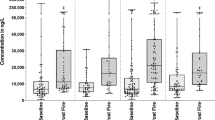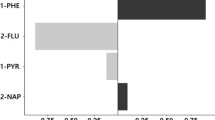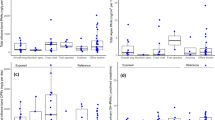Abstract
Cooking oil fumes (COF) contain polycyclic aromatic hydrocarbons (PAHs), heterocyclic aromatic amines, benzene, and formaldehyde, which may cause oxidative damages to DNA and lipids. We assessed the relations between exposure to COF and subsequent oxidative DNA damage and lipid peroxidation among military cooks and office-based soldiers. The study population, including 61 Taiwanese male military cooks and a reference group of 37 office soldiers, collected urine samples pre-shift of the first weekday and post-shift of the fifth workday. We measured airborne particulate PAHs in military kitchens and offices and concentrations of urinary 1-OHP, a biomarker of PAH exposure, urinary 8-hydroxydeoxyguanosine (8-OHdG), a biomarkers of oxidative DNA damage, and urinary isoprostane (Isop). Airborne particulate PAHs levels in kitchens significantly exceeded those in office areas. The concentrations of urinary 1-OHP among military cooks increased significantly after 5 days of exposure to COF. Using generalized estimating equation analysis adjusting for confounding, a change in log(8-OHdG) and log(Isop) were statistically significantly related to a unit change in log(1-OHP) (regression coefficient (β), β=0.06, 95% CI 0.001–0.12) and (β=0.07, 95% CI 0.001–0.13), respectively. Exposure to PAHs, or other compounds in cooking oil fumes, may cause both oxidative DNA damage and lipid peroxidation.
This is a preview of subscription content, access via your institution
Access options
Subscribe to this journal
Receive 6 print issues and online access
$259.00 per year
only $43.17 per issue
Buy this article
- Purchase on Springer Link
- Instant access to full article PDF
Prices may be subject to local taxes which are calculated during checkout


Similar content being viewed by others
References
Chiang TA, Wu PF, Wang LF, Lee H, Lee CH, Ko YC . Mutagenicity and polycyclic aromatic hydrocarbon content of fumes from heated cooking oils produced in Taiwan. Mutat Res 1997; 381: 157–161.
Chiang TA, Wu PF, Ko YC . Prevention of exposure to mutagenic fumes produced by hot cooking oil in Taiwanese kitchens. Environ Mol Mutagen 1998; 31: 92–96.
Pan CH, Chan CC, Huang YL, Wu KY . Urinary 1-hydroxypyrene and malondialdehyde in male workers in Chinese restaurants. Occup Environ Med 2008; 65: 732–735.
Singh VK, Patel DK, Jyoti, Ram S, Mathur N, Siddiqui MK . Blood levels of polycyclic aromatic hydrocarbons in children and their association with oxidative stress indices: an Indian perspective. Clin Biochem 2008; 41: 152–161.
Svecova V, Rossner P, Dostal M, Topinka J, Solansky I, Sram RJ . Urinary 8-oxodeoxyguanosine levels in children exposed to air pollutants. Mutat Res 2009; 662: 37–43.
Pilger A, Rudiger HW . 8-Hydroxy-2′-deoxyguanosine as a marker of oxidative DNA damage related to occupational and environmental exposures. Int Arch Occup Environ Health 2006; 80: 1–15.
Liu X, Meng Z . Effects of airborne fine particulate matter on antioxidant capacity and lipid peroxidation in multiple organs of rats. Inhal Toxicol 2005; 17: 467–473.
Cracowski JL . Isoprostanes: an emerging role in vascular physiology and disease? Chem Phys Lipids 2004; 128: 75–83.
Pan CH, Chan CC, Wu KY . Effects on Chinese restaurant workers of exposure to cooking oil fumes: a cautionary note on urinary 8-hydroxy-2′-deoxyguanosine. Cancer Epidemiol Biomarkers Prev 2008; 17: 3351–3357.
Ke Y, Cheng J, Zhang Z, Zhang R, Shuai Z, Wu T . Increased levels of oxidative DNA damage attributable to cooking-oil fumes exposure among cooks. Inhal Toxicol 2009; 21: 682–687.
Jongeneelen FJ, Anzion RB, Henderson PT . Determination of hydroxylated metabolites of polycyclic aromatic hydrocarbons in urine. J Chromatogr 1987; 413: 227–232.
Tsai PJ, Shih TS, Chen HL, Lee WJ, Lai CH, Liou SH . Urinary 1-hydroxypyrene as an indicator for assessing the exposures of booth attendants of a highway toll station to polycyclic aromatic hydrocarbons. Environ Sci Technol 2004; 38: 56–61.
Maeshima E, Liang XM, Otani H, Mune M, Yukawa S . Effect of environmental changes on oxidative deoxyribonucleic acid (DNA) damage in systemic lupus erythematosus. Arch Environ Health 2002; 57: 425–428.
Lai CH, Liou SH, Lin HC, Shih TS, Tsai PJ, Chen JS et al Exposure to traffic exhausts and oxidative DNA damage. Occup Environ Med 2005; 62: 216–222.
Chuang CY, Lee CC, Chang YK, Sung FC . Oxidative DNA damage estimated by urinary 8-hydroxydeoxyguanosine: influence of taxi driving, smoking and areca chewing. Chemosphere 2003; 52: 1163–1171.
Barr DB, Wilder LC, Caudill SP, Gonzalez AJ, Needham LL, Pirkle JL . Urinary creatinine concentrations in the U.S. population: implications for urinary biologic monitoring measurements. Environ Health Perspect 2005; 113: 192–200.
Shimoi K, Kasai H, Yokota N, Toyokuni S, Kinae N . Comparison between high-performance liquid chromatography and enzyme-linked immunosorbent assay for the determination of 8-hydroxy-2′-deoxyguanosine in human urine. Cancer Epidemiol Biomarkers Prev 2002; 11: 767–770.
Hu CW, Wu MT, Chao MR, Pan CH, Wang CJ, Swenberg JA et al Comparison of analyses of urinary 8-hydroxy-2′-deoxyguanosine by isotope-dilution liquid chromatography with electrospray tandem mass spectrometry and by enzyme-linked immunosorbent assay. Rapid communications in mass spectrometry: RCM 2004; 18: 505–510.
Il'yasova D, Morrow JD, Ivanova A, Wagenknecht LE . Epidemiological marker for oxidant status: comparison of the ELISA and the gas chromatography/mass spectrometry assay for urine 2,3-dinor-5,6-dihydro-15-F2t-isoprostane. Annal Epidemiol 2004; 14: 793–797.
Gariti P, Rosenthal DI, Lindell K, Hansen-Flaschen J, Shrager J, Lipkin C et al Validating a dipstick method for detecting recent smoking. Cancer Epidemiol Biomarkers Prev 2002; 11: 1123–1125.
Wu SC, Yen GC, Sheu F . Mutagenicity and identification of mutagenic compounds of fumes obtained from heating peanut oil. J Food Prot 2001; 64: 240–245.
Wei See S, Karthikeyan S, Balasubramanian R . Health risk assessment of occupational exposure to particulate-phase polycyclic aromatic hydrocarbons associated with Chinese, Malay and Indian cooking. J Environ Monit 2006; 8: 369–376.
Buckley TJ, Lioy PJ . An examination of the time course from human dietary exposure to polycyclic aromatic hydrocarbons to urinary elimination of 1-hydroxypyrene. Br J Ind Med 1992; 49: 113–124.
Nilsson RI, Nordlinder RG, Tagesson C, Walles S, Jarvholm BG . Genotoxic effects in workers exposed to low levels of benzene from gasoline. Am J Ind Med 1996; 30: 317–324.
Kondo K, Watanabe A, Akiyama H, Maitani T . The metabolisms of agaritine, a mushroom hydrazine in mice. Food Chem Toxicol 2008; 46: 854–862.
Sato Y, Nanri H, Ohta M, Kasai H, Ikeda M . Increase of human MTH1 and decrease of 8-hydroxydeoxyguanosine in leukocyte DNA by acute and chronic exercise in healthy male subjects. Biochem Biophys Res Commun 2003; 305: 333–338.
Pan CH, Shih TS, Chen CJ, Hsu JH, Wang SC, Huang CP et al Reduction of cooking oil fume exposure following an engineering intervention in Chinese restaurants. Occup Environ Med 68: 10–15.
Pan CH, Shih TS, Chen CJ, Hsu JH, Wang SC, Huang CP et al Reduction of cooking oil fume exposure following an engineering intervention in Chinese restaurants. Occup Environ Med 2011; 68: 10–15.
Ko YC, Cheng LS, Lee CH, Huang JJ, Huang MS, Kao EL et al Chinese food cooking and lung cancer in women nonsmokers. Am J Epidemiol 2000; 151: 140–147.
Dung CH, Wu SC, Yen GC . Genotoxicity and oxidative stress of the mutagenic compounds formed in fumes of heated soybean oil, sunflower oil and lard. Toxicol In Vitro 2006; 20: 439–447.
Acknowledgements
This research was supported by Ministry of National Defence (Republic of China). JJ was supported by the Academy of Finland Grants No. 129419 (SALVE Research Program).
Author information
Authors and Affiliations
Corresponding author
Ethics declarations
Competing interests
The authors declare no conflict of interest.
Rights and permissions
About this article
Cite this article
Lai, CH., Jaakkola, J., Chuang, CY. et al. Exposure to cooking oil fumes and oxidative damages: a longitudinal study in Chinese military cooks. J Expo Sci Environ Epidemiol 23, 94–100 (2013). https://doi.org/10.1038/jes.2012.87
Received:
Accepted:
Published:
Issue Date:
DOI: https://doi.org/10.1038/jes.2012.87
Keywords
This article is cited by
-
Non-carcinogenic and cumulative risk assessment of exposure of kitchen workers in restaurants and local residents in the vicinity of polycyclic aromatic hydrocarbons
Scientific Reports (2023)
-
Toxicity of cooking oil fumes and prevention of occupational diseases: a literature review
Toxicology and Environmental Health Sciences (2023)
-
What is cooking in your kitchen: seeing “invisible” with time-resolved coherent anti-Stokes Raman spectroscopy
Analytical and Bioanalytical Chemistry (2023)
-
Health risk assessment of polycyclic aromatic hydrocarbons in individuals living near restaurants: a cross-sectional study in Shiraz, Iran
Scientific Reports (2022)
-
Exposure to polycyclic aromatic hydrocarbon-induced oxidative stress in individuals living near restaurants: a cross-sectional study in Shiraz, Iran
Environmental Monitoring and Assessment (2022)



